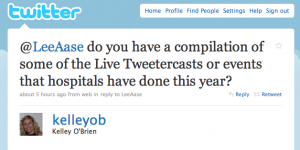[ratings]
Kelley O’Brien (@kelleyob) from North Carolina posed the following question via a tweet this afternoon:
A. I’m not aware of anything like a comprehensive list of hospital Twitter chats. Ed Bennett’s Hospital Social Networking List is a great resource to tell us which hospitals have social media presence, and he even has some great hospital Twitter lists by state, but the list doesn’t include specific projects (such as surgical cases being “tweeted” that have been undertaken by hospitals or healthcare organizations.
But the great thing about social media is that you can build a list pretty quickly by crowdsourcing…via Twitter.
Or at least I think we can. Let’s see!
I’m listing below some of the Twitter chats/events I’ve been involved with through Mayo Clinic, along with some others I’m aware of that others have done.
It’s not even close to exhaustive. But that’s where you come in. If you know of hospitals that have done Twitter events, whether it was related to a surgical procedure, or a communications crisis, or promoting research findings, or whatever other ways you’ve used Twitter (or seen it used) in a hospital setting, please tell about it in the comments below.
Please include the name of the hospital, its Twitter handle, a relevant link to a post, news release or news story describing the effort, and any description you would like to add. Also please indicate which category (listed in bold below) is appropriate. And if you think I’m missing a category that should be added, please tell me that, too.
You also can share your examples via Twitter, using the #HospitalTweets tag. But by adding them in the comments below, they’ll be more permanent (since Twitter doesn’t archive tweets)…and of course, you’re not limited to 140 characters.
I will update this post based on your contributions to create a more comprehensive list.
Let’s see how quickly we can come up with a really good list!
Surgical Case Tweeting
- Henry Ford Health System (@HenryFordNews) and Bill Ferris (@Billfer) were, I believe, the first to do a live-tweeting exercise from the operating room.
- Aurora Health Care (@Aurora_Health) in Wisconsin got significant media attention for tweeting a knee operation.
- HealthOne Presbyterian/St. Luke’s in Denver collaborated with a local TV station on a Twitter procedure, as @angieanania describes.
- Sherman Hospital (@ShermanHealth) did the first live tweeting in Illinois.
Research Communications
- We did a @mayoclinic Twitter chat with @vmontori about a scientific journal article on diabetes and blood-sugar control.
Crisis Communications
- Innovis Health (@InnovisHealth) used Twitter to provide real-time updates during Fargo’s floods in March.
- Scott & White Healthcare (@SWHealthCare) used social media to manage the crisis surrounding the Fort Hood shootings and the victims who had been transported there for care.
Presentations and Training:
- At @MayoClinic, we have held three Tweetcamps to provide training for staff. Here’s a post that describes Tweetcamp III.
- When I do presentations, I regularly include a Twitter back-channel, such as this training seminar on social media I did yesterday with local advocacy chapters of American Heart Association. This is a good way for participants to get hands-on experience with Twitter.
Mainstream Media Collaboration
- @MayoClinic has done Twitter chats with @USAToday and @BrophyMarcUSAT related to this article about an under-diagnosed type of wrist pain that afflicted Philadelphia Phillies Outfielder Jayson Werth, and also about H1N1 flu and kids with asthma, as well as another relating to obsessive-compulsive disorder (OCD) and phobias.
- See the Denver example above in the Surgical Case Tweeting category.
What other examples can you add?


 Technorati:
Technorati: 
